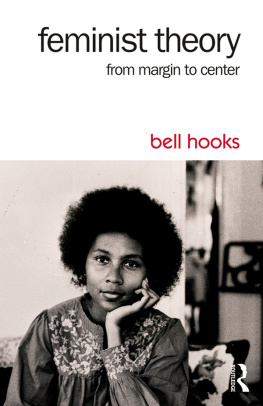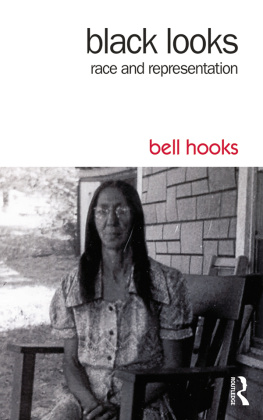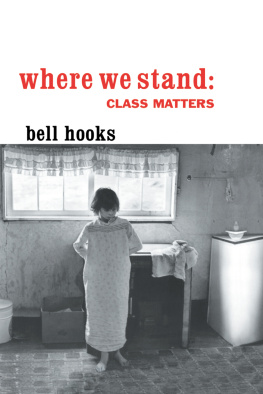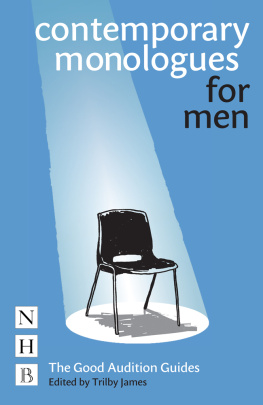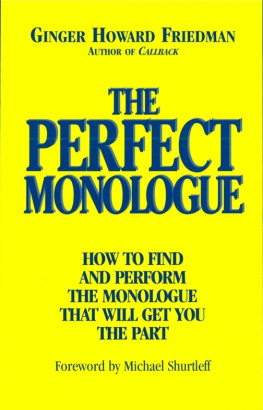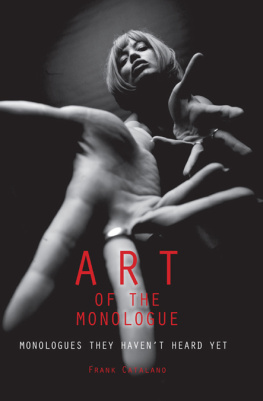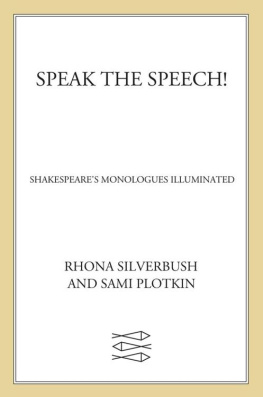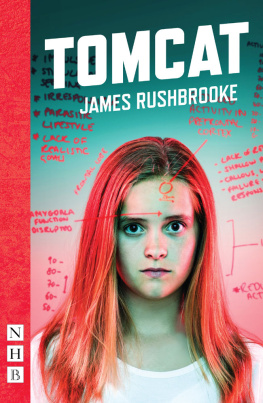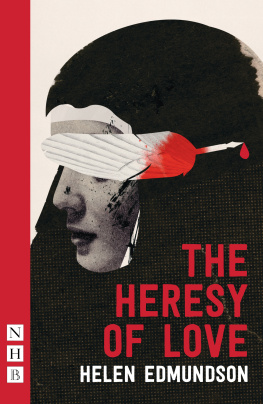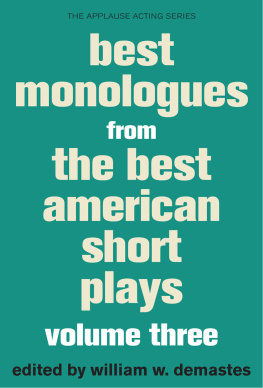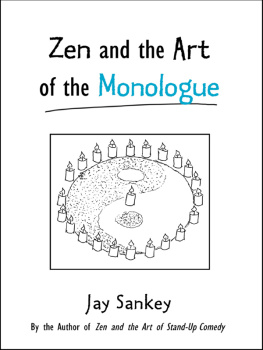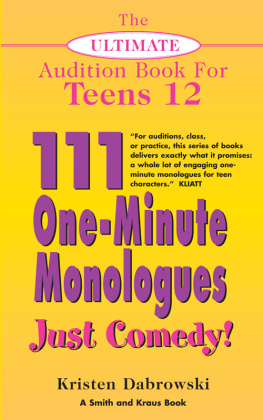I had a friend once said, Norman, I dont care if there are only three people out front, or if the audience laugh when they shouldnt, or dont when they should; one person, just one person is certain to know and understand. And I act for him. Thats what my friend said.
First, thanks must go to Mark Glubke and Robert Nirkind, senior editors at Back Stage Books. I was latevery latewith this final manuscript owing to unforeseen developments in my personal life, and these people could not have been more compassionate or patient. I am deeply appreciative to them both and to the publisher at Watson-Guptill.
Second, I want to thank Matthew Love and his top-notch team at Drama Book Shop in New York City. As has been the case for many years, Drama Book Shop is the best of the best if you are looking for stage material, and I am fortunate that Matthew allowed me limitless access to the plays on the store shelves when I was working on this revision. Without his assistance, I would not have been able to consider the many hundreds of plays I ultimately used.
Talented friends have offered suggestions of plays and scenes, and I am grateful to them. In particular, thanks to Alice Elliott, Russell Treyz, Jean Schiffman, and Le Anne Rumbel.
And, as always, my best editor and cheerleader is my wife, Cally. She keeps the wind gently at my back with her encouragement and support.
CONTENTS
PART ONE
PART TWO
PART THREE
PART FOUR
PART FIVE
PART SIX
PART SEVEN
APPENDIX A
APPENDIX B
INTRODUCTION
The first edition of The Ultimate Scene and Monologue Sourcebook was published in 1994. Many of the plays referenced in that first edition are classics or standards, and so I have left them in this new edition. But there are many revisions: I deleted approximately 15 percent of the plays from the first edition because, after reconsidering them, they felt out-of-date to me, topically irrelevant, or perhaps had gone out of print. And I replaced them with as many new ones. The overall text of this new handbook is actually longer than that of the first edition.
As before, the standard I applied to inclusion was whether or not a play or monologue would work in an acting class or audition. As all professional actors know, conflicts and/or obstacles provide essential elements of a scene or monologue, and I have paid particular attention to where they arise. It is not interesting or theatrically satisfying for an audience to watch two characters on stage simply talking about something. There must be negotiation, either with oneself, with the other character, and/or with the situation. One can be certain that the scenes and monologues from the plays referenced in this book are well structured and playable.
I personally learned a lot about acting while performing in original plays off-Broadway and off-off-Broadway. The challenge with original plays is that while the work itself may be flawed, the actor must nevertheless make it work. It is a different creative process from working on, say, The Glass Menagerie by Tennessee Williams. You know from the start that a Williams play will work. It is up to you, the actor, to find a key that opens it. You dont have to wonder whether the play itself is weak. Everything in this volume has been kitchen-tested in front of paying audiences at one time or another. In short, the plays themselves work. That doesnt mean they are all the modern-day equivalent of Shakespeare, but it does mean that actors and acting teachers can trust them.
HOW TO USE THIS BOOK
The Ultimate Scene and Monologue Sourcebook is a reference tool. It is not like most monologue or scene books. In it, you will find a synopsis of each play, descriptions of scenes, first and last lines, plus notes that I consider pertinent. I may, for example, suggest that a particular play is best for experienced actors rather than for beginners. Pinter, for instance, is usually not the best playwright to start with during initial training (as opposed, say, to Sam Shepard or Arthur Miller) because so much of the conflict is under the surface. When you find something in the book that you want to work on, you will still have to go out and find the complete play. I have not printed entire excerpted scenes or monologues, which is the case in most scene and monologue books. I think it essential that an actor read the whole play.
The book contains seven parts, which you can cross-reference. Part One lists the plays alphabetically and includes a synopsis and analysis of each. If you read through the synopses beginning to end, you likely will find descriptions of plays you want to work on. At the end of each synopsis entry is a reference as to what sort of scenes from the play you will find to work on. There are parts in the book for Male/Female Scenes, Female/Female Scenes, Male/Male Scenes, Female Monologuesand so on. When you find something you like in the synopses, you can easily flip to the appropriate cross-referenced section for further descriptions of individual scenes or monologues.
In the last pages of the book, you will find multiple indexes. You can search the material by playwright, scene type, age, gender, or ethnicity. If you are specifically looking for a play by Eugene ONeill to work on, then go first to the Playwright index and look under ONeill. That will tell you on which pages to look for the material.
Finally, as you use The Ultimate Scene and Monologue Sourcebook, please keep the following provisos in mind. Just because I reference only one or two scenes from a given play does not mean the play does not contain other suitable material. I have tried to list only what I consider to be the strongest material, but it is entirely possible that, when you read the entire play, you will find something you like better.
Whenever possible, I use acting editions as source material. Acting editions are often different from library editions and can lead to a bit of confusion if you are not careful. Take, for instance, the work of Tennessee Williams. He originally wrote many of his plays in a three-act format, but the works also appear in two-act versions because he continued to fiddle with them long after he finished them. To a lesser degree, I encountered the same kind of problem with the works of Lillian Hellman and William Inge. As a result, if you select a scene or monologue that is referenced here but then cant find the material in the compilation from your local library, dont despair. It is probably in the text somewhere; you just need to do a little more investigating. If, however, you are unable to locate the scene or monologue in question, you might wind up having to order an acting edition of the play. For this reason, and because many of the referenced plays cant be found in libraries, I included contact information for a few major theatrical retailers.
Ed Hooks
Chicago
July 2007
PART ONE
PLAY SYNOPSES/ANALYSES
ABSENT FRIENDS
by Alan Ayckbourn (Samuel French)
S YNOPSIS : Colins fiance recently drowned, and a group of former friends have invited him to a tea party to lift his spirits. The problem is that his friends have marital and other personal problems of their own, and Colin is quite happy with his sentimental memories. The more they try to take his mind off his deceased lover, the more he insists on talking about her, which depresses everyone. He then good-naturedly tries to solve their problems, which makes the get-together even more disastrous.




